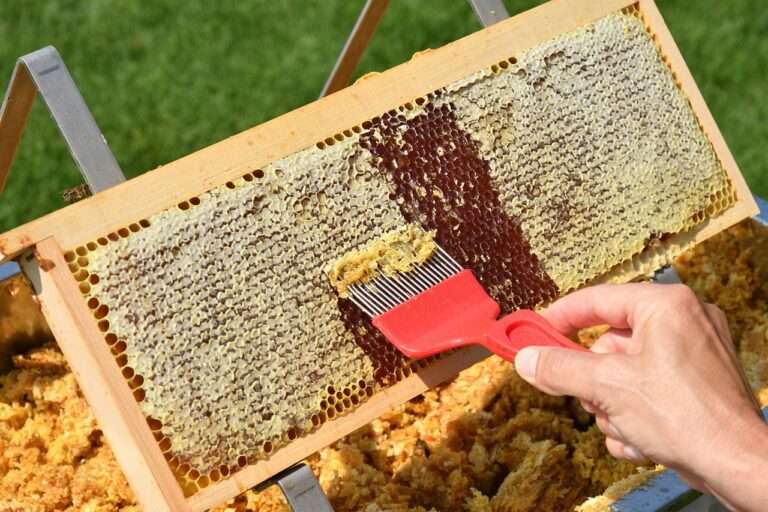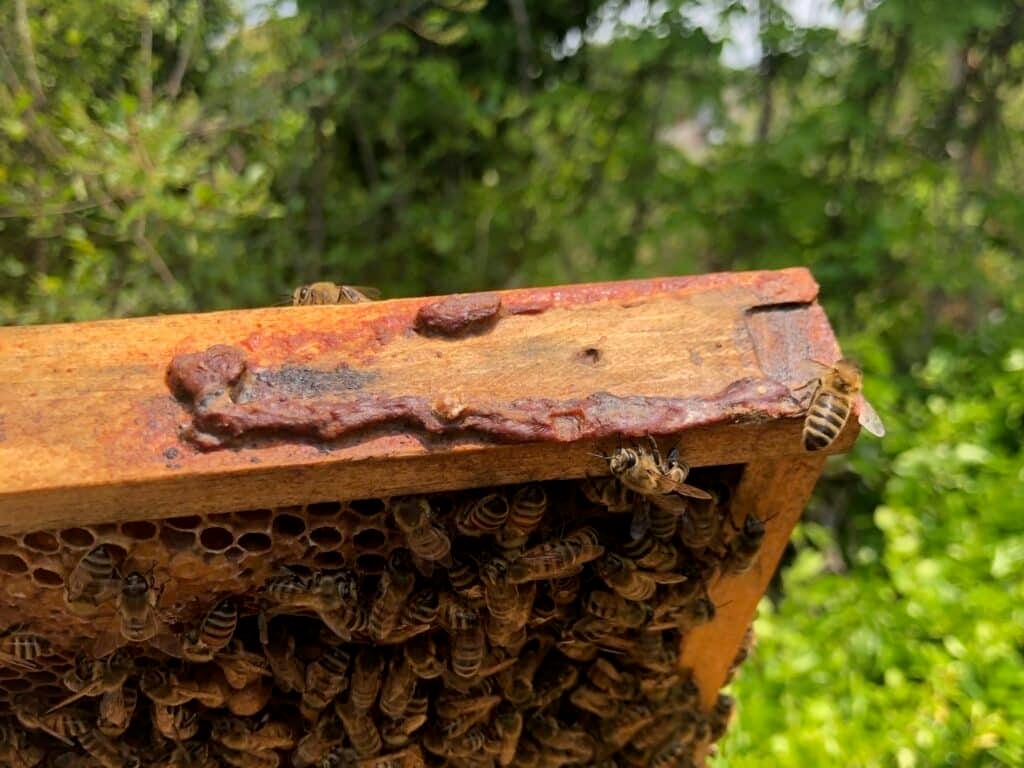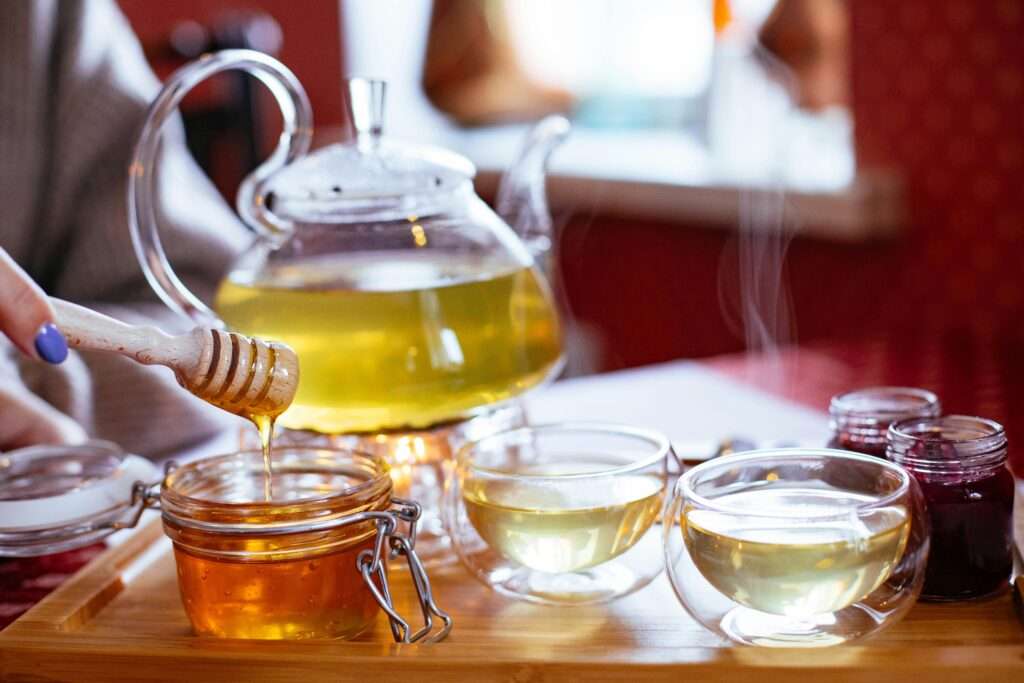Key gear for getting honey from the hive and typical cost
| Stage | What you need | Typical price range (USD, July 2025) | Notes |
| Removing bees from the super | – Bee brush ($5–15) – Fume or escape board ($20–35) | $5–35 | Gently clears frames before extraction[1]. |
| Uncapping the comb | – Cold knife or serrated “hot” knife ($20–100) – Cappings fork ($10–25) | $10–100 | Knife slices wax cappings; fork reaches low spots[2][1]. |
| Extracting the honey | – Manual radial extractor, 2-3 frames $100–300 – Electric extractor, 3-6 frames $300–800 – Commercial radial, 12-20+ frames $1,300–3,000 + | Price climbs with frame capacity and electric motors[3][4][5]. | |
| Filtering & collecting | – Double-sieve stainless strainer ($35–60) – Food-grade 5-gallon bucket with honey gate ($25–50) | $25–60 | Removes wax bits before bottling[2]. |
Honey extractors: how they differ
- Frame orientation
- Tangential – spins one side at a time; must flip frames. Cheaper, better for hobbyists.
- Radial – baskets radiate from the center so both sides empty at once; faster but higher cost.
- Power source
- Hand-crank: quiet, no electricity, $100–300 for 2-4-frame units—ideal up to ~5 hives.
- Construction
- Food-grade stainless steel walls and steel or plastic baskets; stainless resists rust and cleans easily, worth the premium for frequent use.
What it really costs to extract a season’s honey
Option A – Own the gear (small hobbyist, 4 hives)
- 2-frame manual extractor ≈ $150
- Knife, fork, strainer, bucket set ≈ $120
- Misc. (bee brush, escape board) ≈ $40
Up-front outlay ≈ $310. Spread over five seasons that’s about $62/year plus your labor.
Option B – Rent/extraction service
- DIY on shop equipment: $2 per medium frame, 20-frame minimum → $40/super plus $40 booking deposit (applied to bill)[6].
- Full-service drop-off: $4 per medium frame or $40/super; you pick up strained honey later[6][7].
Break-even: if you process fewer than two supers a year, paying a service is usually cheaper than owning.
Option C – Mid-scale beekeeper (15–20 hives)
- 6-frame electric radial extractor with legs ║ $1,295[4]
- Cappings tank, bottling tank, uncapping plane, etc. ║ ~$700
Total ≈ $2,000; but one operator can pull 300–400lb/day, recouping cost in a season if selling retail.
Ongoing expenses & time
- Cleaning extractor: 20–30 min—run warm water, wipe, air-dry. Mild soap only; honey residues dissolve easily[3].
- Wear parts: motor belts ($15) every few seasons, food-grade grease for bearings.
- Electricity for a 6-frame unit: roughly 0.1 kWh per load—pennies.
Tips for efficient, high-quality harvest
- Extract within 24 h of pulling supers; warm honey flows faster and reduces risk of small hive beetle invasion.
- Keep room near 90 °F/32 °C or warm frames overnight; viscosity drops sharply.
- Spin slowly at first to avoid blow-outs, then full speed once cells lighten.
- Strain twice (coarse then fine) before bottling; consumers dislike wax flecks.
- Save wax cappings—render for candles or trade; they contain up to 8% of your crop’s honey weight if un-drained.
In short, a hobbyist can start extracting for about $300, while serious sideliners invest $1,000-3,000 in electric radials.
Processing services charge $2–5 per frame, a convenient alternative when harvest volume is low or capital is tight.
⁂
- https://www.betterbee.com/harvesting-and-processing/harvesting-and-processing.asp
- https://blythewoodbeecompany.com/products/basic-honey-harvesting-equipment-kit
- https://blythewoodbeecompany.com/blogs/news/honey-extractors-a-comprehensive-guide-to-types-maintenance-and-best-practices
- https://www.dadant.com/catalog/honey-harvesting/honey-processing/extractors
- https://cozpalace.com/collections/honey-extractor
- https://gypsyshoalsfarm.com/products/honey-extraction-services-self-service-or-full-service
- https://rockymountainbeesupply.com/pages/honey-extraction
Ad – Amazon Affiliate Store
Bestseller #1
- PREMIUM QUALITY MATERIAL: The Hive Scraper Tool honey harvesting equipment is made of ABS material, with thick plastic a…
- PERFECT SIZE: The uncapping knife is ergonomically designed with a Z-shaped wooden handle that is 4.65 inches long for a…
- FUN DESIGN: The Honey Uncapping Tank Holder is designed with a unique groove that fits perfectly into the 5-gallon bucke…
$17.89
Bestseller #2
- Versatile Tool: This 18-pin stainless steel uncapping fork is designed for efficiently uncapping honeycomb frames during…
- Durable Construction: Featuring a sturdy yellow plastic handle and rust-resistant stainless steel tines, this tool is bu…
- Efficient Design: The fork’s dense array of pins allows for quick and thorough uncapping of honeycomb cells.
$6.97
Bestseller #3
- Pakage Includes: you will receive 1honey bucket with honey gate, 1uncapping knife, 1uncapping fork, 1bee hive frame grip…
- Generous 5 Gallon (20l) Capacity: the honey bucket is made of food-grade PP material, ensures the safety and purity of y…
- Easy to Use: the beehive brushes are soft and flexible, help you draw out bees from beehives and frames without hurting …
$52.99
Bestseller #4
- Beekeeping Supplies Tool Set: 5 gallon honey bucket * 2, honey uncapping tank holder * 2, honey gate, stainless steel ho…
- 15-in-1 beekeeping supplies: honey harvesting equipment includes almost all beekeeping and honey harvesting tools
- Efficient Honey Extraction: The beehive frame holder and honey bucket rack extractor equipment is perfect for holding ho…
Bestseller #5
- Comprehensive Beekeeping Tool Kit: this 28-piece beek eeper tool set includes everything you need for beekeeping, includ…
- Efficient Honey Extraction Tools: this beehive starter kit contains 1 honey decapping knife and 2 honey decapping forks,…
- Beekeeping Protective Equipment: veil with fence hood It is made of waterproof and breathable material, and has a cincha…
$55.99
Bestseller #6
- Double Sieve: Featuring a two-stage filtration system, the 1875 micron coarse upper mesh captures beeswax debris, while …
- 304 Stainless Steel: With 304 stainless steel mesh, this strainer is durable, highly resistant to rust and oxidation, an…
- Large Capacity: The mesh bowl has a diameter of 9.4″ with a depth 4″ and features extendable arms with a total reach of …
$19.99
Bestseller #7
- It’s designed for checking the quality of honey and other high sugar related liquids.
- 3-in-1 scale design makes you know three indexes at one time:honey moisture/ brix/ baume.
- Measuring Range: Water Content (Moisture) 12-27%, Brix 58-90%, Be’ (Baume) 38-43. Division: 0.5% Water, 0.5% Brix, 0.25 …
$22.88
Bestseller #8
- Made of high-quality materials, durable.
- Easy to clean, lightweight and practical.
- High-quality plastic handle material, smooth, not hurting hands, comfortable grip, cutting honey more labor-saving, conv…
$9.99
Bestseller #9
- Essential Beekeeping Equipment:Our 2pcs uncapping knife set is made with high-grade stainless steel and wooden handle, e…
- Ergonomic Wooden Handle: Honey uncapping knife is designed with a comfortable wooden handle,provides a secure grip and r…
- Precise and Effective: With its serrated edge,our stainless steel uncapping knife effortlessly cuts through the wax capp…
$13.99
Bestseller #10
- 1.The sharp tines plastic prongs can ensure you extract honeycombs perfect ! Easily extract honey.
- 2.Detachable.High quality plastic and steel welding to ensure that the handle strong.
- 3.Please keep the Needle Roller in the warm water to clean the product.
$13.95
Bestseller #11
- Automatic Temperature Control:This electric honey uncapping knife quickly heats up and maintains an optimal temperature …
- Effortless Honey Harvesting:The heated blade of honey uncapping knife glides through wax seals with ease, minimizing res…
- Durable Construction: Made with stainless steel blade and a comfortable, non-slip hardwood handle, this electric hot unc…
$23.99














